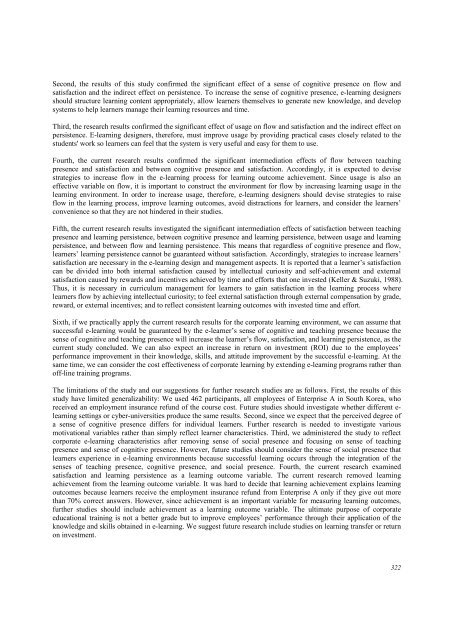Download Complete Issue in PDF - Educational Technology & Society
Download Complete Issue in PDF - Educational Technology & Society
Download Complete Issue in PDF - Educational Technology & Society
You also want an ePaper? Increase the reach of your titles
YUMPU automatically turns print PDFs into web optimized ePapers that Google loves.
Second, the results of this study confirmed the significant effect of a sense of cognitive presence on flow and<br />
satisfaction and the <strong>in</strong>direct effect on persistence. To <strong>in</strong>crease the sense of cognitive presence, e-learn<strong>in</strong>g designers<br />
should structure learn<strong>in</strong>g content appropriately, allow learners themselves to generate new knowledge, and develop<br />
systems to help learners manage their learn<strong>in</strong>g resources and time.<br />
Third, the research results confirmed the significant effect of usage on flow and satisfaction and the <strong>in</strong>direct effect on<br />
persistence. E-learn<strong>in</strong>g designers, therefore, must improve usage by provid<strong>in</strong>g practical cases closely related to the<br />
students' work so learners can feel that the system is very useful and easy for them to use.<br />
Fourth, the current research results confirmed the significant <strong>in</strong>termediation effects of flow between teach<strong>in</strong>g<br />
presence and satisfaction and between cognitive presence and satisfaction. Accord<strong>in</strong>gly, it is expected to devise<br />
strategies to <strong>in</strong>crease flow <strong>in</strong> the e-learn<strong>in</strong>g process for learn<strong>in</strong>g outcome achievement. S<strong>in</strong>ce usage is also an<br />
effective variable on flow, it is important to construct the environment for flow by <strong>in</strong>creas<strong>in</strong>g learn<strong>in</strong>g usage <strong>in</strong> the<br />
learn<strong>in</strong>g environment. In order to <strong>in</strong>crease usage, therefore, e-learn<strong>in</strong>g designers should devise strategies to raise<br />
flow <strong>in</strong> the learn<strong>in</strong>g process, improve learn<strong>in</strong>g outcomes, avoid distractions for learners, and consider the learners’<br />
convenience so that they are not h<strong>in</strong>dered <strong>in</strong> their studies.<br />
Fifth, the current research results <strong>in</strong>vestigated the significant <strong>in</strong>termediation effects of satisfaction between teach<strong>in</strong>g<br />
presence and learn<strong>in</strong>g persistence, between cognitive presence and learn<strong>in</strong>g persistence, between usage and learn<strong>in</strong>g<br />
persistence, and between flow and learn<strong>in</strong>g persistence. This means that regardless of cognitive presence and flow,<br />
learners’ learn<strong>in</strong>g persistence cannot be guaranteed without satisfaction. Accord<strong>in</strong>gly, strategies to <strong>in</strong>crease learners’<br />
satisfaction are necessary <strong>in</strong> the e-learn<strong>in</strong>g design and management aspects. It is reported that a learner’s satisfaction<br />
can be divided <strong>in</strong>to both <strong>in</strong>ternal satisfaction caused by <strong>in</strong>tellectual curiosity and self-achievement and external<br />
satisfaction caused by rewards and <strong>in</strong>centives achieved by time and efforts that one <strong>in</strong>vested (Keller & Suzuki, 1988).<br />
Thus, it is necessary <strong>in</strong> curriculum management for learners to ga<strong>in</strong> satisfaction <strong>in</strong> the learn<strong>in</strong>g process where<br />
learners flow by achiev<strong>in</strong>g <strong>in</strong>tellectual curiosity; to feel external satisfaction through external compensation by grade,<br />
reward, or external <strong>in</strong>centives; and to reflect consistent learn<strong>in</strong>g outcomes with <strong>in</strong>vested time and effort.<br />
Sixth, if we practically apply the current research results for the corporate learn<strong>in</strong>g environment, we can assume that<br />
successful e-learn<strong>in</strong>g would be guaranteed by the e-learner’s sense of cognitive and teach<strong>in</strong>g presence because the<br />
sense of cognitive and teach<strong>in</strong>g presence will <strong>in</strong>crease the learner’s flow, satisfaction, and learn<strong>in</strong>g persistence, as the<br />
current study concluded. We can also expect an <strong>in</strong>crease <strong>in</strong> return on <strong>in</strong>vestment (ROI) due to the employees’<br />
performance improvement <strong>in</strong> their knowledge, skills, and attitude improvement by the successful e-learn<strong>in</strong>g. At the<br />
same time, we can consider the cost effectiveness of corporate learn<strong>in</strong>g by extend<strong>in</strong>g e-learn<strong>in</strong>g programs rather than<br />
off-l<strong>in</strong>e tra<strong>in</strong><strong>in</strong>g programs.<br />
The limitations of the study and our suggestions for further research studies are as follows. First, the results of this<br />
study have limited generalizability: We used 462 participants, all employees of Enterprise A <strong>in</strong> South Korea, who<br />
received an employment <strong>in</strong>surance refund of the course cost. Future studies should <strong>in</strong>vestigate whether different elearn<strong>in</strong>g<br />
sett<strong>in</strong>gs or cyber-universities produce the same results. Second, s<strong>in</strong>ce we expect that the perceived degree of<br />
a sense of cognitive presence differs for <strong>in</strong>dividual learners. Further research is needed to <strong>in</strong>vestigate various<br />
motivational variables rather than simply reflect learner characteristics. Third, we adm<strong>in</strong>istered the study to reflect<br />
corporate e-learn<strong>in</strong>g characteristics after remov<strong>in</strong>g sense of social presence and focus<strong>in</strong>g on sense of teach<strong>in</strong>g<br />
presence and sense of cognitive presence. However, future studies should consider the sense of social presence that<br />
learners experience <strong>in</strong> e-learn<strong>in</strong>g environments because successful learn<strong>in</strong>g occurs through the <strong>in</strong>tegration of the<br />
senses of teach<strong>in</strong>g presence, cognitive presence, and social presence. Fourth, the current research exam<strong>in</strong>ed<br />
satisfaction and learn<strong>in</strong>g persistence as a learn<strong>in</strong>g outcome variable. The current research removed learn<strong>in</strong>g<br />
achievement from the learn<strong>in</strong>g outcome variable. It was hard to decide that learn<strong>in</strong>g achievement expla<strong>in</strong>s learn<strong>in</strong>g<br />
outcomes because learners receive the employment <strong>in</strong>surance refund from Enterprise A only if they give out more<br />
than 70% correct answers. However, s<strong>in</strong>ce achievement is an important variable for measur<strong>in</strong>g learn<strong>in</strong>g outcomes,<br />
further studies should <strong>in</strong>clude achievement as a learn<strong>in</strong>g outcome variable. The ultimate purpose of corporate<br />
educational tra<strong>in</strong><strong>in</strong>g is not a better grade but to improve employees’ performance through their application of the<br />
knowledge and skills obta<strong>in</strong>ed <strong>in</strong> e-learn<strong>in</strong>g. We suggest future research <strong>in</strong>clude studies on learn<strong>in</strong>g transfer or return<br />
on <strong>in</strong>vestment.<br />
322

















